Over the past several years, we have uncovered many impressive histories connected with Glen Park. One not yet discussed is the Glen Park connection to the glamor and glitz of Hollywood that began during the earliest days of Tinseltown. This is the last of 5 posts (see Part 1 , The Glen Park Glenodeon; Part 2, Bob Lippert, King of the B’s; Part 3, Glen Park Aeronaut on the Big Screen; and Part 4, Gregg Palmer, Glen Park’s Hollywood Cowboy.
Sometimes, a local girl can make good. At the turn of the 20th century, a move to the Fairmount District just 4 miles from downtown San Francisco, was like a move to the country. Wedged between Glen Park, Noe Valley, and the route of the Southern Pacific Railroad, Fairmount offered affordable lots and convenient transportation for city workers, many of whom were cogs in the great machinery of a city that glittered with silver and gold. What follows is the life history of a young girl from those earlier days of rural Fairmount who did make it big, first on radio, then later in Hollywood where she became an unforgettable 1960s television icon.
At the age of 52, James Merritt Noblitt (sometimes listed as Noblett) would be one of the many who rushed to the pastoral suburbs of Fairmount after the 1906 San Francisco earthquake. Hailing from the Blue Ridge Mountains of North Carolina, Noblitt stood at 6’3”, a towering figure when the average height of males after the Civil War was about 5’7”. He worked as a farmer until he enlisted in the 18th US Army Infantry at Nashville, Tennessee, in 1877. Two years later, his regiment was reassigned to Fort Assinniboine in northern Montana near the Canadian border, an area that was still being used as the hunting grounds of the Lakota Sioux after their earlier escape into British Northwest Territory. Under intensely frigid conditions during the early months of 1881, the 18th Infantry would pursue, unsuccessfully, a party of Chief Sitting Bull’s Sioux warriors as they escaped back into Canada. (Soon after, Chief Sitting Bull would surrender and return to the United States). After spending time in Fort Leavenworth, Kansas, in 1889 the 18th Infantry was reassigned to the warmer climes of Texas, eventually settling in at Fort Bliss in El Paso.
At the outbreak of the Spanish-American War in 1898, the 18th US Infantry became part of the 2nd Battalion of the 8th US Army Corps. Before traveling to the Philippines, the unit bivouacked in San Francisco for training at Camp Merritt, located in the sand dunes near the Presidio between today’s Geary Boulevard, Fulton and Arguello Streets, and Sixth Avenue. After landing at Manila Bay in August of that year, Noblitt and the 2nd Battalion actively participated in the taking of Manila. Soon after, Noblitt was discharged from the service in 1899 as a sergeant, for an undescribed disability. He returned to El Paso to be with his wife of 15 years, Katie (née Katherine McSharry), a native of Ireland.
The Noblitts would have two daughters: Annie, born in 1885 while her father was stationed at Fort Leavenworth, and Jessie Irene, arriving 17 years later in 1902 while the family was still at Fort Bliss. In 1904, the Federal government appointed Noblitt as a watchman (a predecessor to customs and immigration agents), attached to the San Francisco Custom House under what was then called the US Chinese Bureau. With his new salary of $840 per year (about $16,000 today), Noblitt picked up his family and relocated to San Francisco. They first resided at 50 South Park, once the hobnobberish district of San Francisco before the wealthy would charge up Nob Hill, taking it as their own in the 1870s. By the time the Noblitts were moving in, South Park was populated by working class residents of mixed ethnicities, many of whom were employed on the wharves.
The US Chinese Bureau was responsible for enforcing federal immigration law under the Chinese Exclusion Act of 1882. Before the Angel Island Immigration Station opened officially in 1910, immigrants of all nationalities were processed at the docks of the Pacific Mail Steamship Company at South Beach. Upon arrival, immigrants were processed and segregated by nationality. Immigrants from Asia, Russia, Mexico, and those needing quarantine for health reasons were transferred to Angel Island for greater isolation, driven by the fear and repugnance exhibited by local residents who resisted sharing the opportunities America offered that they were enjoying.
In January 1906, the San Francisco Call reported on the “scrupulous vigilance” of Chinese Inspector Noblitt while on duty at the Mail docks. As the report goes, a young Chinese laborer was claiming he was an American native and was seeking readmission to the United States. While being held in the detention shed, a local Chinese resident had brought food for those who were waiting. During his inspection, Noblitt found a package of peanuts on the laborer and, “…took the package apart and examined each peanut separately, even eating several in order to determine whether they had been grown in Virginia or Fresno. He came to a large shell that was rather lightweight and on closer examination found that the nuts had been removed from the shell, a letter inserted, and the halves of the shell stuck together with mucilage. The letter consisted of 103 Chinese characters upon a slip of paper five inches long by two inches wide. Dr. John Endicott Gardner reported that the note was a coaching letter instructing the immigrant fully as to the story he should tell the officials in order to be admitted.” The fate of the young laborer is unknown.
In early 1907, James and Katie Noblitt purchased a lot “on the lines of Arlington and Miguel” from William J. and Delia (née Hannigan) Sullivan, natives of Ireland who had emigrated to San Francisco in the early 1850s. The Sullivans had built their home on Arlington in the mid-1880s – a house that still stands today near Charles Street. William was the proprietor of the Sullivan Hay, Grain, and Feed at Charles Street situated on either side of the Bernal Cut (today’s San Jose Avenue). A Sullivan lumber yard was also located nearby. William and Delia bore 11 children, some of whom also chose to remain on Arlington to raise their own families. By the time the Noblitts moved in, neighbors were calling Arlington Street “Sullivan Alley” because of the number of ever-present Sullivan children playing and running in all directions. Young Jessie Irene attended the nearby Fairmount Grammar School at Chenery and Randall (today the Dolores Huerta Elementary School) and likely spent a lot of time with the Sullivan kids.
The Noblitt home was an attached, 1-bedroom, wood-frame dwelling located at 39 Arlington, just across the street and down some from William’s and Delia’s house. According to the 1905 Sanborn Fire Insurance Map for the district, that would place their home about midway between Charles and Miguel Streets. The backyard of the Noblitt residence led to a steep slope that angled down to the Bernal Cut where Southern Pacific trains chugged by regularly both day and night. Today, 39 Arlington would be located on the 200 block; the numbering of Arlington Street was changed around 1930 when the Bernal Cut was widened to accommodate both Southern Pacific Railroad cars and automobiles. Unfortunately, the Noblitt residence would be one of several structures moved, or more likely, demolished at the time the cut was widened (according to the 1930 US Federal Census, Katie Noblitt had moved to Pope Street in the Crocker-Amazon district).
James M. Noblitt died unexpectedly on March 6, 1913. He was given military honors and buried at the National Cemetery at the Presidio. Five days later, Katie published a card of thanks in the San Francisco Call addressed to the United Spanish-American War Veterans and members of the Sixth U.S. Infantry at the Presidio “…for their kindness and sympathy extended to her and her children in her late bereavement.” By this time, eldest daughter Annie was 28 years old, married, and living in Alameda. That left Katie and 11-year-old Jessie Irene on their own and fending for themselves.
Soon, Irene was only using her middle name. As an adult, she was described as, “… a tiny lady barely 5 feet tall [more likely 5’2”, according to some reports] with sparkling blue eyes.” In several interviews, Irene shared how her career began at age 11 when she won $3.00 singing “Pretty Baby” at the Valencia Theater in San Francisco (located at Valencia near 14th Street). “I wore a pink silk dress and had long curls. I was terrified. If they didn’t like the act, the audience would throw tomatoes and eggs. They even had a hook in the wings to pull off performers if you weren’t any good. The manager told me I wouldn’t get hit with the garbage if I sang loud enough. I didn’t want my pink dress to get ruined, so I sang “Pretty Baby” at the top of my lungs. I won first prize and I’ve been singing loud ever since.”
In a 1967 interview in TV Guide, Irene added that her first acting job was in 1917 at Joyland Park in Sacramento. Because her widowed mother did not approve of “play actors,” by summer’s end they were packing to go home to San Francisco so that Irene could attend high school. Before packing was done, Irene received an offer to play with the Ed Redmond Company, one of a multitude of traveling stock companies of the era. At first, Katie Noblitt would have nothing of it. But another mother standing within earshot of their debate argued with Katie about sending Irene back to school, exclaiming, “This kid’s got talent!” Fifteen-year-old Irene, with two years of high school under her belt and an inflated age to avoid being caught under California child labor laws, was soon boarding a train to Phoenix, Arizona.
By the time the Redmond Follies arrived in her birthplace of El Paso in August 1918, Irene had already become a principal player among its 25 members. The troupe was promoted in El Paso newspapers as including the “wizard of drumology” and incorporating “special stage settings, novel electrical effects, elaborate costuming and a myriad of novel stage effects…guaranteed to give one hour and ninety minutes of cyclonic entertainment.” In one performance, “Miss Irene Noblitt scored with ‘I’m Old Enough for a Little Lovin’ and ‘Sweet Babette.’” Irene’s renditions of “Sweet Little Buttercup” and “Everybody’s Crazy ‘Bout the Blues” were also “heartily received,” and “her solos received much applause.”
Described as a “chic soubrette” in an interview in September 1918, Irene shared she was, “…doing scads of things off stage, including studying music and Spanish.” She went on to describe why she hated publicity: “It’s because I’m afraid of the photographers. I was photographed but once in my life. Three others have been published with my name attached, but somebody else sat for them. One was pretty but the other two were sights. Somebody told me they got them out of what they call their ‘morgue’ and I believed it.” As for being interviewed she shared, “I think that actresses who talk too much take all the glamor that being on the stage gives them. One discreet entrance at the stage door is worth 40 tea parties. When you go on the stage you go on sort of an automatic heritage!…You’re an actress! You’re a distinguished person without having done one mortal thing. The thing that must be remembered is that the easy distinction is easily lost…if you prattle about your likes and dislikes, and your amusements and your fads, it takes people only about five minutes to discover that you’re a very ordinary mortal, and actress or no actress, like every other person in the world. All any actress has to do to hold her legacy of charm is to keep still. The habit of the public mind will do the rest.”
The Redmond Follies returned to San Francisco for a 1-year run before closing the show for the 1919 season in El Paso. Irene returned to San Francisco to perform in vaudeville. Back home at 39 Arlington and living with her mother Katie, her sister Annie, and Annie’s husband, Virgil Wilkerson, Irene listed her occupation in the 1920 US Federal Census as theater actress. In the spring of 1921, she was back with the Redmond Follies, this time in San Jose. She noted how she and the troupe had frequented the Vendome natatorium that she described as “a noted bathing resort close to San Jose.” [Author’s note: she is likely referring to the Crystal Pool at the Hotel Vendome. Constructed in the late 1880s, the Hotel Vendome was located on North First Street in San Jose, offering lodging for visitors to the nearby Lick Observatory.] She notes they were looking forward to being part of their opening at Sunset Heights near El Paso that also offered opportunities for bathing. According to Irene, “The art of swimming is the king of outdoor pastime with the show girl, especially the dancing girl, for it develops all the muscles in the body and gives one a lot of pep and ginger for the evening show…most of the girls of our company wear the California bathing suit, made famous by Mack Sennett diving girls and I feel assured they will pass the board of censorship in the city of El Paso.”
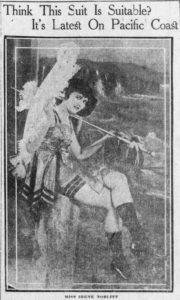
By the summer of 1921, Irene had left the Redmond Follies and branched out on her own in El Paso, initially as the Irene Noblitt-Johnny Rader Combination performing at the Texas Grand in “The Biggest Liar in the World.” That fall she appeared with Rader in Charles Alphin’s Follies Company where, again, she was noted to be the “soubret [sic] of the company.” The following year in St. Joseph, Missouri, Irene married Tim Ryan, an actor in The Wilson Company, who she had met on the road. The two continued with the company and by 1935 were maintaining a residence on Forest View Avenue in Burlingame, California.
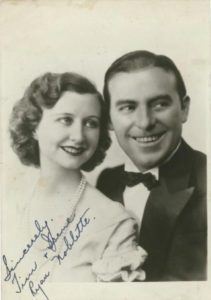
During the Depression, as the public taste for vaudevillian old-school humor waned and performance opportunities dried up, in 1931 the pair made the transition to radio in its early golden days. First appearing on NBC Blue and later NBC Red, Ryan played the straight man and “Noblette” as “Dumb Dora” was “loony and squeaky” (akin to the comedy of George Burns and Gracie Allen). They would be a reappearing comedy duo from 1934 to 1935 on an NBC vaudeville-style variety show out of San Francisco called Carefree Carnival. In addition to their own show, Tim and Irene 1937 to 1939, Irene appeared on the long-running Texaco Star Theater variety show on CBS Radio and hosted by Eddie Cantor (later, the program would successfully transition to television and be the platform enabling comedian Milton Berle to be dubbed “Mr. Television”). Using her married name by the 1940s, Irene had become a popular actor. From 1943 to 1947, she appeared as another “bumbling and dumb” character on Campbell Soup’s The Jack Carson Show on CBS radio, and from 1945 to 1947 appeared on The Eddie Bracken Show (NBC Radio) as “the eternal helper who always managed to leave a situation more muddled.” She also frequently appeared on the long-running The Bob Hope Show (NBC Radio) into the early 1950s.
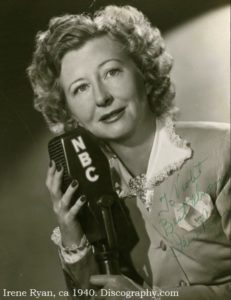
After divorcing Ryan in 1943, she married her second and last husband, producer Harold Knox, in 1946. They would divorce in 1961. By this time, Irene had become known as “the gal who makes Bob Hope laugh.” She frequently accompanied him for United Service Organizations (USO) tours to entertain troops stationed in the United States and abroad (sometimes in active war zones), a mission Hope would continue for over half a century. Then came the television role that would make her an icon.
In the years following World War II, the generation that bore the Baby Boomers (known as the Silent, or Greatest Generation) had launched a mass exodus to the suburbs. By the early 1960s, Americans seemed to be longing for a more rural state of mind. CBS Television recognized the desire and took advantage of the opportunity by developing programs with a rural theme, including Green Acres with Eddie Albert and Eva Gabor (1965 to 1971), and Petticoat Junction with Edgar Buchanan, Linda Henning, and Bea Benaderet (1963 to 1970). Both were spin-offs of the now-classic The Beverly Hillbillies, with Buddy Ebsen, Arlington Street’s own Irene Ryan, Max Baer, Jr., and Donna Douglas.
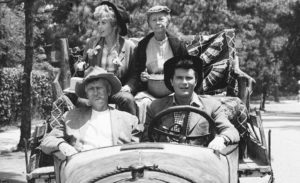
One need only listen to the theme song of The Beverly Hillbillies, performed by Bluegrass masters Lester Flatt and Earl Scruggs, to get the gist of the plot (released in October 1962, the extended radio version of The Ballad of Jed Clampett zoomed to Number 1 on the Billboard Hot Country Singles chart and number 44 on the Billboard Hot 100): Jed Clampett [Buddy Ebsen], family patriarch of a poor family living in abject poverty in the backwoods of the Missouri Ozarks, is out hunting one day when his shot misses the mark. “Black gold, Texas tea” (crude oil) comes bubbling up out of the ground. After selling his land to an oil company, his “kinfolk” advise, “Californy is the place you ought to be, so they loaded up the truck and they moved to Beverly … Hills, that is. Swimmin’ pools, movie stars.” With $25 million in his pocket ($200 million today), they purchase a mansion in Beverly Hills next to their banker, Mr. Drysdale. According to one Beverly Hillbillies fan website, “Frequently, plots involved the outlandish efforts taken by Drysdale to keep the Clampetts in Beverly Hills and their money in his bank. The family’s periodic attempts to return to the mountains were often prompted by Granny [Irene Ryan] due to a perceived slight she received from one of the ‘city-folk.’”
Irene later commented that the role of Jed’s mother-in-law, the rustic, pipe-smoking, double-barrel-rifle-totin’ matriarch, Granny Clampett (whose scripted name was Daisy May Moses), had been difficult to win. In her first audition at the age of 60, she was told she was too young for the part. She responded to the producers, “What do I have to do? Go home and get my grey wig and shawl to convince you? If you get anybody older than me to play the role, she won’t be able to stand the pace. I know what those 7-to-7 schedules are like.” She came back later that day, dressed in her grey wig and shawl, and tested against 3 other actresses. She won the part. Irene shared after the premier of The Beverly Hillbillies: “A show like this comes along once in a performer’s lifetime. It’s the most wonderful thing that ever happened to me. The minute I saw the pilot script I knew it would make a big hit…Both Buddy [Ebsen] and I have been near the top many times, but we never quite made it. Now we’re up there and I can assure you it feels mighty good.”
While The Beverly Hillbillies storyline might not satiate the comedic or cultural appetites of Americans today, they were feasting on it in the 1960s. Only 5 weeks after its premier, The Beverly Hillbillies had zoomed to number 1 in the Nielsen ratings and there it stayed for 2 years, surpassing the ratings of The Bob Hope Show, a feat never before accomplished. In an ever-changing world, shows like The Beverly Hillbillies served as a place where Americans, unwilling or unable to face the crises of the day, could escape from the realities of the Cold War, threat of nuclear aggression, a growing risk of conflict in Southeast Asia, and the ongoing fight for African American civil rights, a cultural inertia that until only recently has persisted. When President John F. Kennedy was assassinated on November 22, 1963, the 3 half-hour episodes of The Beverly Hillbillies in the weeks following the tragedy are today some of the most-watched half-hour programs in the history of television. And according to a You.GovAmerica 2021 survey of the all-time favorite TV shows, Baby Boomers, Generation Xers, and Millennials ranked The Beverly Hillbillies Number 25 in a list exceeding 1000 programs, surpassing the likes of Cheers, The Dick Van Dyke Show, The X-Files, Star Trek, Little House on the Prairie, Gunsmoke, Friends, Seinfeld, and the Mary Tyler Moore Show. The show also had a major impact on casual fashion. An executive of San Francisco legacy company Levi Strauss once said that Jed’s daughter, Ellie May (played by Donna Douglas), “had done more for the sale of blue jeans in one year than cowboys have done in a hundred.”
The Beverly Hillbillies remained on the air until 1971. During that time the show received 7 Emmy nominations in categories for Outstanding Program Achievement in the Field of Humor (1963), as well as acting, directing, and writing. The show never received the award. Irene Ryan was nominated with Mary Tyler Moore and Lucille Ball for Best Actress in 1963, but Shirley Booth would win for her role as the maid in Hazel. She was again nominated for Best Actress in 1964, but that would be the year Mary Tyler Moore would win her first Emmy.
In October 1972, Irene opened on Broadway in a play directed and choreographed by Bob Fosse, playing the role of Berthe, the “lusty” mother of King Charlemagne and maternal grandmother of the title character, Pippin, played by Ben Vereen. Appearing in 8 shows a week, her 9 minutes on stage singing “No Time at All” was considered a showstopper. At the time, she commented how, “At home in Santa Monica, I’m used to opening my front door and picking roses and avocados from my garden. I look out of my window at the Pacific Ocean. Here [New York City], all I look out on is the hotel across the street.”
While reports vary, in March 1973 Irene appears to have suffered a stroke while onstage or immediately following one of her performances. She returned to her home in California to recuperate but passed away 6 weeks later, reportedly due to a brain tumor (glioblastoma), on April 27, 1973.
Between her two marriages, Irene never had any children. Two years before her death, Irene had donated $1 million to establish the Irene Ryan Foundation to award scholarships to deserving students to attend the Kennedy Center American College Theater Festival in Washington, DC. A half century later, her foundation continues to award 16 regional and 2 national scholarships annually to students wanting to pursue their education in the arts.
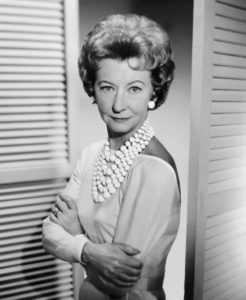
Clearly an elegant woman in photographs, Irene once shared how she, “… got into comedy because I ain’t no beauty. My face is homely and my figure dumpy … but I work steadier than a lot of gorgeous starlets.” Irene Ryan’s diminutive stature is far outweighed by her legacy both on- and offstage for her nearly 60-year career. The ditzy roles she played were typical of society’s view of women in general during those years and certainly were not representative of her gracious persona. Her role as Granny Clampett on The Beverly Hillbillies provided escapism from an increasingly maddening world. She made the nation laugh – not too bad for a girl who grew up on Arlington Street in Fairmount.
Listen to samples from Irene’s radiography, including The Jack Carson Show and The Bob Hope Show; view a video of a Tim and Irene performance; hear Irene’s rendition of “No Time at All” from Pippin and get an idea of the talent “that kid” had in 1917 in Sacramento; and according to the TV Guide, The Beverly Hillbillies is still available for viewing on several cable networks and streaming services.
Evelyn Rose, Director and Founder of the Glen Park Neighborhoods History Project, is documenting the histories of Glen Park and nearby neighborhoods. To learn more about our local histories, visit www.GlenParkHistory.org. The Glen Park Neighborhoods History Project is currently offering intermittent virtual programs during the ongoing health crisis. Join the mailing list: GlenParkHistory@gmail.com. The Glen Park Neighborhoods History Project is fiscally sponsored by Independent Arts & Media, a California non-profit corporation. Evelyn is also the author of the history website, Tramps of San Francisco.
